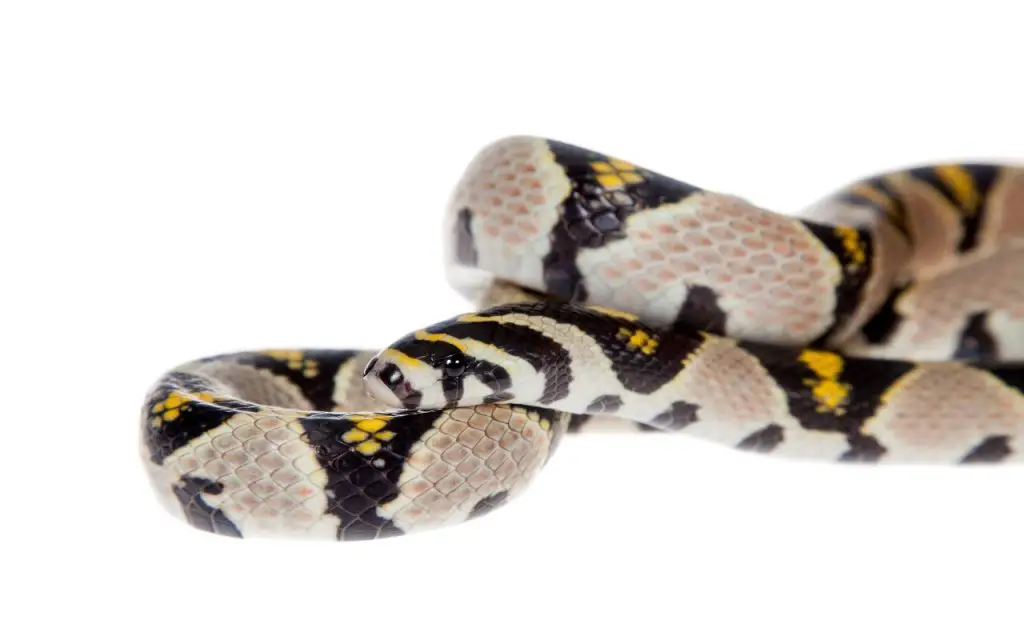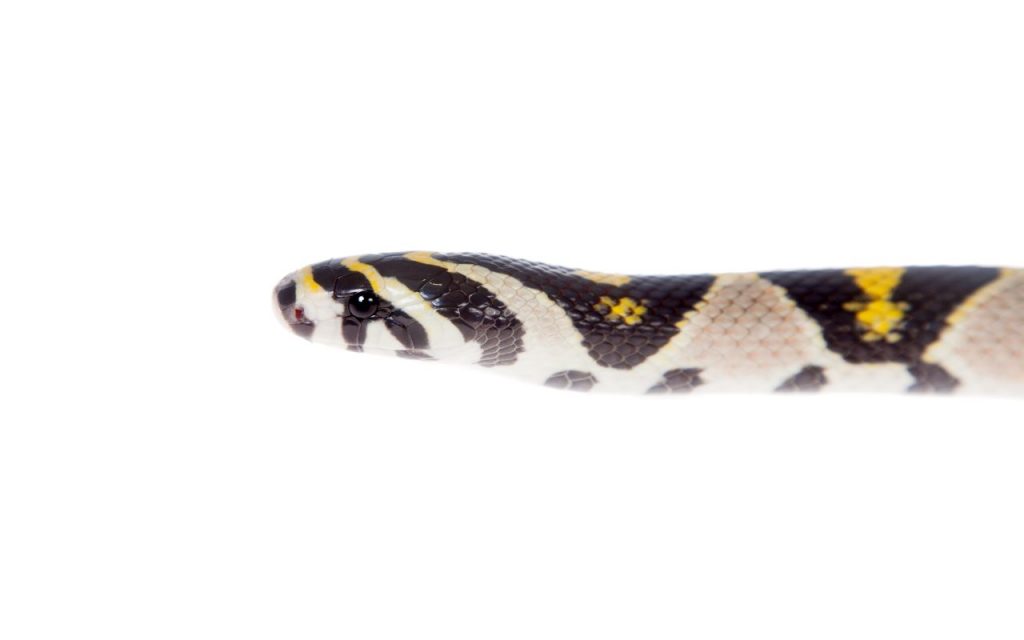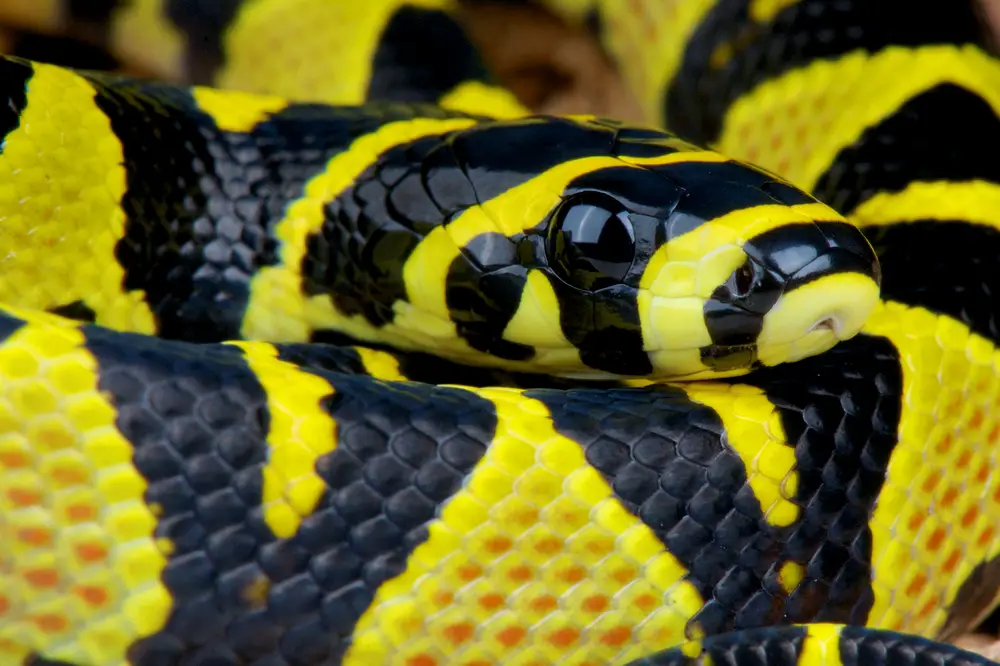Come and read my Mandarin Rat Snake Care sheet to learn how to look after one of my “dream snakes”. Simply put, this is one of the most stunning snakes in the world…
Last updated on February 1st, 2023 at 09:23 am
Euprepiophis mandarinusa is the Mandarin Rat Snake, an animal prized by reptile enthusiasts thanks to its absolutely stunning markings. Like many colubrids, it is fairly easy to care for. However, it likes cooler temperatures than new world rat snakes, and this is a crucial factor to get right when caring for it.
Mandarin Rat Snake enclosure
The Mandarin Rat Snake can be kept in a terrarium or a plastic tub, just make sure there is adequate ventilation. While getting a terrarium care should be taken to provide more floor space rather than height.
While choosing a cage, it must be ensured that ventilation is provided, but that it is also able to maintain humidity. For example, you should choose an enclosure with a few air vents, rather than one with a full mesh top.
Younger hatchlings should be kept in a tub. This will ensure that they don’t feel lost in a large tank.
Mandarin Rat Snake tank size
The ideal Mandarin rat snake tank size is 120quarts/30gallons/113liters. If a tub is being used (for hatchlings), then the tub size can be 41 quart/10gallons/37liters.
While this is the ideal size, you can even consider getting a larger sized tank. A large size would allow your pet snake to be more comfortable. Only move it to a larger tank than 30 gallons if it is a fully grown adult that is active and feeding well, however.
Your pet will flourish with more space available in the tank. As mentioned, more ground space is needed since height is not an issue.
With a larger sized tank you may be tempted to keep more than one snake in a tank. This is not recommended as it could lead to fights that may turn out to be violent.
They don’t hurt each other seriously, but often two males will fight and the loser will go into a sulk, becoming stressed and refusing food. It’s mostly a case of hurt pride, but any form of stress should be taken seriously and avoided.
As with any shy species, it’s important to think carefully about where to put your snake’s enclosure. It needs to be somewhere quiet, and out of direct sunlight.

Substrate and hiding places
The tank where the Mandarin rat snake is kept needs a substrate. You can even use a cage liner made of paper or good old fashioned newspaper, though this isn’t the best option.
Mandarin rat snakes like to burrow and hence you should really provide substrate with loose particles. Aspen chips or coco chips would be ideal.
Cypress mulch is another option for use as substrate. You need to avoid wood shavings made from pine or cedar, since its odor is too strong and may be toxic.
There must be enough cover, so the snake is comfortable. The snake is shy by nature and prefers hiding places. Snug hide boxes can be provided in the enclosure. This would give your pet space to hide
Mandarin Rat Snake temperature
As I mentioned earlier in the article, Mandarin Rat Snakes like much cooler temperatures than New World rats snakes such as Corn Snakes and Eastern Rat Snakes.
Ideally, they need a temperature in the 70s. A range of 60 to 80 degrees Fahrenheit would suffice, with 60F on the cool end and 80F on the warm.
The only care needed is to ensure the temperature does not cross 85 degrees. The Mandarin rat snake can tolerate cooler temperatures, so if the temperature goes low it is not really a problem.
If, on the other, you overheat this species it will quickly decline in health.
Water
The snake needs fresh water, which you need to make available at all times. While providing water, take care of provide a strong dish that the snake does not topple.
Being reclusive as they are, you might not see your snake drink on a regular basis. I can promise you, however, that it is sneaking out and drinking on a regular basis. Fresh water should always be available, and the dish should be cleaned at least once a week.

Humidity and shedding
The humidity of the tank or enclosure where you keep your pet Mandarin rat snake should be from 60-70% at all times. You may need a humidity gauge to be able to measure the humidity. In general, this humidity level is easiest to maintain in plastic tubs. Bear in mind that the substrate shouldn’t be wet either, this is the ambient humidity we’re talking about.
Bear in mind that the substrate shouldn’t be wet either, this is the ambient humidity we’re talking about. This can lead to blisters or respiratory-related disorders. When you are keeping hatchlings, you must know they shed at a faster rate. This presents the risk of getting dry fast so monitor their humidity every day.
The enclosure may dry and hence a tub with ventilation at the sides is ideal for hatchlings. It is important that ventilation should be adequate to prevent mold for forming.
To ensure the right humidity, you can water spray the enclosure once every few days.
Size
The size of the Mandarin rat snake would be around 100 to 120 centimeters (between 3 and 4 feet long). This is the average size of the adult species.
As with most snake species, I’ve heard lots of people talk about much larger individuals – but never seen them! All in all, if you get one of these snakes it is highly unlikely that it will get over 4ft (120cm) in length.
So far, the largest one on record was about 4.5ft (if my memory serves me well).

Diet
In the wild, the Mandarin rat snake prefers to eat rodents. They mostly eat small mice. They prefer to stay in rodent burrows from where they hunt, kill, and eat rodents.
When bred in captivity, they should be fed mice. They tend to digest food at a slower rate, which is why it is better to feed them smaller meals.
They can be fed mice once a week. It is advisable to only offer feeder mice that are bought from a pet shop, rather than trapped. It is very important that the mice offered should not be larger than the widest part of the snake’s body. This species likes small meals, and has a hard time digesting large ones.
These snakes search for rodent nests and devour the young. This is why you can bury small mice in the substrate, so the snake can find it and eat it.
This can be done if your snake is finicky and not eating properly. It is a method that is recommended to feed hatchlings, so their natural predatory behavior gets stimulated.
Mandarin Rat Snake temperament
The temperament of the Mandarin rat snake is what makes it popular as a pet. It is a shy reptile and not aggressive. Since it has no venom, it poses no danger. Even though it has fangs, it is unlikely to bite.
The only reason it would bite is if it feels threatened or if it is not handled properly. You should ideally avoid handling this snake if you keep it as a pet.
Even if you handle, do it very gently. Allow the snake to run over your hand. Do not hold the snake in your hand. Avoid gripping it or squeezing.
This can make it panic and try to flee. It may even bite when it feels nervous. You must not handle hatchlings too much as they are nervous by nature. They are more likely to bite if handled.
Overall, they are a pretty nervous species. They display a range of amusing defense mechanisms, including:
- quickly burrowing into their substrate
- wriggling and thrashing like a worm
- musking on you with foul-smelling liquid from their cloaca
- striking (rarely)
Notwithstanding, they almost always calm down with gentle handling over a period of weeks. It just takes a little time. You shouldn’t be put off because lots of colubrids are like this. Eventually, your Mandarin Rat Snake could end up being as docile as a Ball Python.

Mandarin Rat Snake breeding
The information about breeding will be useful if you plan to breed this snake at home. This information will also help you understand how the snake is bred in captivity.
This snake will brumate before it mates. It usually stops feeding a couple of weeks beforehand. To replicate this in captivity, you simply reduce temperature by around 110-15F, and keep them that low for a couple of months.
Keep water for the snake when it brumates, but do not offer food. Ensure you don’t disturb the snake.
After brumation, return the temperature to normal. You can then resume feeding the snake. Once 3 weeks is complete after brumation, you can start the process of breeding. You need to introduce the female snake into the male’s tank.
During the process of mating, the male would bite the neck of the female. Once mating is over, the snakes separate. This process can continue for many times. It may take up to 5 attempts for the female to become pregnant.
After successful mating, the female will lay eggs after 2 months. Usually, it lays anywhere from 2 to 9 eggs. You can incubate the eggs using a medium of vermiculite and water. A temperature of 25 to 28 degrees Celsius (77 to 82 F) has to be maintained during incubation.
The hatchlings emerge from the eggs 45 to 60 days after the eggs are laid. You need to wait for around 7 to 10 days after which the hatchling would shed its skin.
Once the first shedding happens, you can then feed the hatchling. Give them small mice to feed. During the process of breeding, maintaining temperature is the key. If the temperature becomes too high, the snakes can fall ill.
Mandarin Rat Snake for sale and price
If you are looking to buy a Mandarin rat snake, then you need to find authentic sources. There are online markets where you can buy Mandarin rat snakes. Generally, you’ll find it easiest to local a reliable breeder by going to Morphmarket.com. There, you can see breeders’ ratings from previous buyers.
The average price of a Mandarin rat snake is $400 to $500.
If you want a Red line Mandarin rat snake, you should be prepared to pay $1400. A yellow gray Mandarin rat snake would cost $800, while a Krumke Mandarin rat snake would cost $1,000.
Mandarin Rat Snake Care summary
| Temperature: | 60 to 80 degrees Fahrenheit would suffice, with 60F on the cool end and 80F on the warm. Mid 70s seems to be best. |
| Humidity: | 60-70% |
| Favourite food: | Mice |
| Enclosure size: | For adults: any enclosure with a capacity of 120quarts/30gallons/113liters. For juveniles and subadults: an enclosure with a capacity of 41 quart/10gallons/37liters |
| Activity rythm: | Crepuscular, but semi-fossorial so rarely seen |
| Lighting needs: | UV light not necessary, but ambient lighting beneficial |

FAQs relating to Mandarin Rat Snake care
The FAQ’s below contain commonly asked questions and answers related to the care of the Mandarin Rat Snake. It will help you get more information about caring for this snake.
Are Mandarin rat snakes venomous?
The Mandarin rat snake is a non-venomous species of snake. Rat snakes are in general a breed of snakes that do not have venom. Since the Mandarin rat snakes do not have venom, they are not dangerous to humans. This is why they are kept as pets.
If you keep this species of snake as pet, you can rest assure that the snake is not harmful. Like most colubrids, their teeth are tiny, and can only manage a slight scratch at the most.
Are Mandarin rat snakes aggressive?
Mandarin rat snakes are excessively shy reptiles. They avoid getting into contact with humans. They are usually not aggressive and prefer to burrow under the soil or hide to avoid exposure.
They are not venomous, but can deliver a bite if they get scared enough. They do not bite or show any aggressive behavior unless they feel threatened.
While adult Mandarins rarely bite, hatchlings can bite. The younger snakes are more nervous and are very likely to bite from fear if people come into contact with them.


Hi Will, l can’t thank you enough for your site and your articles – this is one of my top 3 go to addresses whenever l want solid information about reptiles, and l dare say thanks to you l am now the proud owner of a stunning little Mexican rosy boa. 😊 Please keep up the great work!! All the best from NL, Franka
Hi Franka,
Thank you for supporting the site – your comment made my day! I’m extremely grateful to have loyal readers like yourself. Also, congratulations on getting your Mexican Rosy Boa, they are one of my all-time favorite pet snakes.
All the best,
Will